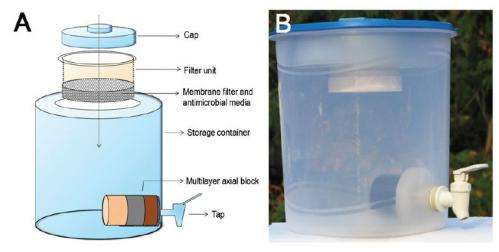May 7, 2013 report
Nano-scientists develop new kind of portable water purification system

(Phys.org) —Researchers at India's Institute of Technology Madras have developed a new kind of portable water purification system based on nanoparticle filtration. In their paper published in the Proceedings of the National Academy of Sciences, the team explains how their new device does its job—it employs nanoparticles to remove not just biological hazards, but toxic heavy metals as well.
The researchers note that access to clean drinking water is still a major worldwide problem—making it available to everyone, they say, would save approximately 2 million lives a year (approximately 42.6 percent of deaths are due to diarrhea alone and impact mostly children). To help reach the UN millennium development goal of doubling the number of people with sustainable access to safe drinking water by 2015, the team has been applying nanoparticle technology to the problem.
The system they have developed is a two-stage filtration process that provides 10 liters of clean water in just an hour's time. The biggest challenge, the team says, was figuring out how to deliver silver ions into the water to be processed, without using any electricity. The process also had to use a minimal amount of silver ions to meet international safety standards. The answer, they say, was to use a new material that employs silver nanoparticles that are trapped in tiny cage-like structures made of other clay materials.
Other nanoparticles are used to create other materials that serve as filters, killing microbes and sucking heavy metals out of the water, making it safe to drink or use for cooking. The first stage of the process kills viruses, bacteria and other dangerous micro-biota. The second stage absorbs heavy metals such as lead and arsenic.
The result is an extremely inexpensive portable water purification device—the system cost is comparable to other portable filtration systems, but the processing itself comes to less than $3 per year. The filters are good for approximately one year (3,600 liters) and filtration can be run more than once per day if needed. The researchers believe their device is capable of providing all the drinking water a family of four would need.
The researchers have not yet made it clear who will manufacture the new device or when it might be made available for sale.
More information: Biopolymer-reinforced synthetic granular nanocomposites for affordable point-of-use water purification, PNAS, Published online before print May 6, 2013, doi: 10.1073/pnas.1220222110
Abstract
Creation of affordable materials for constant release of silver ions in water is one of the most promising ways to provide microbially safe drinking water for all. Combining the capacity of diverse nanocomposites to scavenge toxic species such as arsenic, lead, and other contaminants along with the above capability can result in affordable, all-inclusive drinking water purifiers that can function without electricity. The critical problem in achieving this is the synthesis of stable materials that can release silver ions continuously in the presence of complex species usually present in drinking water that deposit and cause scaling on nanomaterial surfaces. Here we show that such constant release materials can be synthesized in a simple and effective fashion in water itself without the use of electrical power. The nanocomposite exhibits river sand-like properties, such as higher shear strength in loose and wet forms. These materials have been used to develop an affordable water purifier to deliver clean drinking water at US $2.5/y per family. The ability to prepare nanostructured compositions at near ambient temperature has wide relevance for adsorption-based water purification.
Journal information: Proceedings of the National Academy of Sciences
© 2013 Phys.org













